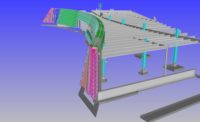A Total Look: The Power of GIS, 3D BIM Together

Building information modeling (BIM) —the digital representation of the physical and functional characteristics of a facility, and a shared knowledge and information resource about a facility —renders virtual models of structures for architecting or remodeling at any phase of a structure’s life cycle. BIM models can follow the facility from inception to demolition.
Once BIM models have been constructed to cover the details of a given facility, they can continue to follow the structure through its natural life cycle and the digital BIM representation can be integrated into other software such as asset management and preventive maintenance systems.
It is the integration of these systems that gives facility managers, engineers, architects and others a “total look” at a structural asset from virtually every vantage point, enabling informed decisions.
From a cost and labor standpoint, the beauty of BIM has always been its noninvasiveness. Architects and builders can see the electrical, plumbing, heating and cabling “bones” of structures in virtual renderings, and they can determine how to build around them with minimal disruption. Because BIM can plug into an assortment of other digital technologies, it also seems natural that to extend it to work with geospatial imagery and GIS in general.
As early as March 2009, in a research paper developed about the integration potential of BIM with asset management systems, researchers from the School of the Built Environment at the University of Salforddiscussed the viability of BIM and asset management system integration for building design and maintenance, pointing out that an infusion of GIS technology into standard BIM can transform BIM into a super app.
At that time researchers concluded, “3D modeling is just one aspect of BIM that has hogged the limelight, but its real strength and power lies in the knowledge database, which can be used in conjunction with other software to deliver quick and reliable information in areas of sustainability, estimating, structural analysis, demolition and reconstruction.”
Since then, BIM users have incorporated GIS data into 3D modeling for building construction, civil engineering projects, agriculture and mining projects and even real estate and property tracking. Nevertheless, a major sticking point within companies and between engineering and geomatics firms has been the work silos that keep the BIM and GIS disciplines separated instead of actively collaborating with one another.
“There is a need for the parallel worlds of geospatial and construction industry to merge today,” say Bram Mommers, senior consultant, information management, and Simon Rawlinson, partner, head of strategic research and insight at Arcadis, in a work they co-authored “The worlds of construction and geo-information have been working closely for many years, but there have not been any efforts to integrate it until recently.” But, while the geospatial world makes maps, engineers and architects produce drawings. Engineers and architects use CAD or BIM design tools. Geospatial experts use GIS. They noted this separation extends into the way in which the disciplines develop.
Geospatial activities are typically in different departments from construction within architecture, engineering and construction AEC companies. Even though they are often trying to achieve the same goals, there can be different initiatives and innovation projects in both the worlds. “This situation is wasteful and unsustainable,” they say.
Mommers and Rawlinson advocate an information and communication technology system (ICT) that can integrate GIS and BIM systems and also foster a more collaborative and interactive environment for GIS specialists and BIM engineers. They believe the worldwide software open source community, together with the growth of open standards and systems interfaces, can enable different systems to readily exchange information with each other to help facilitate this blend.
There are also transformative forces that are already at work, and that are driving construction and other industries to take deeper looks at how they can more effectively leverage the benefits of BIM by combining it with geospatial, GIS and other systems. One of these forces is an accelerating adoption of systemsolutions that use integrated BIM, imagery, geospatial information, 3D visualization and geospatially-enabled data management
A prime example of BIM and geospatial/GIS system integration in action are the projects being undertaken to better understand urban infrastructure and growth.
“Over half of the world's 6 billion population lives in cities and this proportion is expected to increase as we move toward 9 billion by 2050,”says Geoff Zeiss, former director of the Utility Industry Program at Autodesk and now a principal at Between the Poles, a thought leadership consultancy. “This is driving investment in new and refurbished buildings and infrastructure. The world's construction industry including buildings, electric power, water and wastewater, roads, rail, sea ports and airports contributes about $7 trillion annually or 10 percent of the world GDP. Over the next two decades these sectors will see a massive infusion of investment estimated in the range of $20 to $50 trillion. In addition, as governments find they have less and less money for capital infrastructure projects, a greater proportion of the investment in infrastructure will come from the private sector, which will drive an increased focus on productivity to improve returns on investment.”
Private sector investors won't be tolerant of the cost overruns that frequently characterize construction projects. Arcadis cited the Light Rail Groningenproject where it was discovered that pre-existing mapping data was not completely accurate. Project engineers took corrective action by using laser scanning technology that was able to correct the deficiencies so that the risk of erroneous construction assumptions from poor data that could create extra costs could be avoided. In similar fashion, Geoff Zeiss talked about LondonHeathrow airport’s Map Live system, which allows everyone within the business to query (including geospatial query), retrieve and view information about the geolocations of Heathrow's underground infrastructure, or the city of Las Vegas’s intelligent 3D model of one-and-a-half miles of Main Street in the older section of the city that provides information about the infrastructure underlying the buildings, as well as above-ground information on the buildings themselves, on roadways, on utilities and on telecommunications.
Will more coordination between BIM and GIS professionals, coupled with aggressive integration of BIM and geospatial/GIS systems continue to move forward?
Art Kalinsky, GISP, who established the U.S. Navy’s first geographic information system in the mid-1980s, believes there will be new breakthroughs based upon BIM and geospatial/GIS technology integration that will utilize virtual and augmented reality for better visualization; greater exploitation of oblique aerial imagery that will assist GIS professionals so they can more easily work with mapping data; the development of commercial software that will not only create BIM/geospatial/GIS renderings of single structures, but renderings of entire city blocks; and the ability to capture continuous rapid multiple LiDAR images/point clouds, merging these with continuous high-resolution optical images to create full-color 3D models that can be interactively geo-referenced in real time.
Many of these technologies are only beginning to emerge, but it is certain that cost, time and accuracy pressures will continue to move builders, city planners and architects into a hybrid business model that effectively blends elements of geospatial and GIS with BIM and other ancillary technologies because their customers and constituents will demand it.
Looking for a reprint of this article?
From high-res PDFs to custom plaques, order your copy today!




.png?height=200&t=1741772985&width=200)
